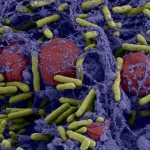Link to Pubmed [PMID] – 23633677
Sci Signal 2013 Apr;6(273):ra30.1-11, S1-3
Chemokines promote the recruitment of leukocytes to sites of infection and inflammation by activating conventional heterotrimeric guanine nucleotide-binding protein (G protein)-coupled receptors (GPCRs). Chemokines are also recognized by a set of atypical chemokine receptors (ACRs), which cannot induce directional cell migration but are required for the generation of chemokine gradients in tissues. ACRs are presently considered “silent receptors” because no G protein-dependent signaling activity is observed after their engagement by cognate ligands. We report that engagement of the ACR D6 by its ligands activates a β-arrestin1-dependent, G protein-independent signaling pathway that results in the phosphorylation of the actin-binding protein cofilin through the Rac1-p21-activated kinase 1 (PAK1)-LIM kinase 1 (LIMK1) cascade. This signaling pathway is required for the increased abundance of D6 protein at the cell surface and for its chemokine-scavenging activity. We conclude that D6 is a signaling receptor that exerts its regulatory function on chemokine-mediated responses in inflammation and immunity through a distinct signaling pathway.

